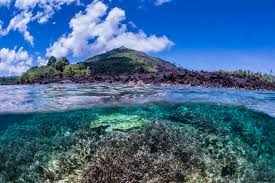Introduction to Raja Ampat
Raja Ampat, an archipelago located off the northwest tip of Bird’s Head Peninsula in West Papua, Indonesia, is often hailed as one of the world’s premier diving destinations. Known as the “Four Kings,” Raja Ampat consists of over 1,500 small islands, cays, and shoals surrounding the four main islands of Misool, Salawati, Batanta, and Waigeo. This remote paradise is renowned for its staggering marine biodiversity, vibrant coral reefs, and crystal-clear waters, making it a dream destination for divers from around the globe.

Why Raja Ampat is a Diver’s Paradise
Raja Ampat’s waters are part of the Coral Triangle, a region recognized as the global epicentre of marine biodiversity. Divers in Raja Ampat can encounter an astonishing variety of marine life, including over 1,500 species of fish, 550 species of coral, and numerous species of sharks, rays, and turtles. The diversity of dive sites means that whether you’re interested in drift diving, wall diving, or exploring underwater caves and wrecks, Raja Ampat has something to offer.
Best Time to Dive in Raja Ampat
The best time to dive in Raja Ampat is during the dry season, which runs from October to April. During this period, the seas are calmer, and visibility is at its peak, often exceeding 30 meters. The water temperature is consistently warm, ranging between 27°C and 30°C, making for comfortable diving conditions. While diving is good year-round, the rainy season from May to September can bring rougher seas and reduced visibility.
Top Dive Sites in Raja Ampat
 Raja Ampat offers a wide array of dive sites, each with unique features and marine life. Here are some of the top dive sites you shouldn’t miss:
Raja Ampat offers a wide array of dive sites, each with unique features and marine life. Here are some of the top dive sites you shouldn’t miss:
1. Cape Kri
Located off the island of Kri, this site is famous for holding the world record for the most species of fish recorded in a single dive. The strong currents bring nutrient-rich waters, attracting large schools of fish, including barracudas, trevallies, sweetlips, reef sharks, and turtles.
2. Blue Magic
As the name suggests, this site offers magical underwater experiences. It’s a pinnacle dive site where you can encounter manta rays, schools of jacks, and even the occasional hammerhead shark. The currents can be strong, making it a site for more experienced divers.
3. Manta Sandy
One of the best places to see manta rays in Raja Ampat, Manta Sandy is a cleaning station where these gentle giants come to be cleaned by smaller fish. Divers can observe manta rays up close as they glide gracefully through the water.
 4. Misool Island
4. Misool Island
Misool’s dive sites are renowned for their pristine coral gardens and rich biodiversity. Sites like Boo Windows and Magic Mountain offer breathtaking underwater landscapes and encounters with species like pygmy seahorses, nudibranchs, and reef sharks.
5. The Passage
A narrow channel between Waigeo and Gam islands, The Passage offers a unique diving experience. The combination of shallow coral reefs, steep walls, and mangrove forests creates a rich and varied environment where you can spot everything from small critters to large pelagics.
Liveaboards vs. Land-Based Diving
When planning a diving trip to Raja Ampat, you have two main options: liveaboard diving or staying at a land-based dive resort.
– Liveaboard Diving
Liveaboards are a popular choice for divers who want to explore the more remote and diverse sites of Raja Ampat. These vessels offer the advantage of accessing dive sites that are difficult to reach from land-based resorts. A typical liveaboard trip lasts from 7 to 12 days, allowing divers to cover a wide range of dive sites across the archipelago.
– Land-Based Diving
For those who prefer staying on land, there are several dive resorts located on the main islands of Raja Ampat. These resorts offer comfortable accommodations and daily dive trips to nearby sites. While the range of dive sites may be more limited compared to liveaboards, land-based diving can be more flexible and suitable for divers who prefer shorter trips or more relaxation time between dives.
Essential Tips for Diving in Raja Ampat
1. Bring the Right Gear
Raja Ampat is remote, and while most dive operators provide rental gear, it’s advisable to bring your own well-fitted mask, snorkel, fins, and dive computer. A 3mm wetsuit is usually sufficient due to the warm water temperatures.
2. Prepare for Sume Currents
Some of the best dive sites in Raja Ampat are known for decent currents. It’s essential to have good buoyancy control and be comfortable with drift diving. If you’re less experienced, consider taking a drift diving course before your trip.
3. Respect the Marine Environment
Raja Ampat is a protected area, and it’s crucial to practice responsible diving. Avoid touching or damaging corals, and be mindful of your buoyancy to prevent accidental contact with marine life. People are also prohibited from wearing dive gloves in Raja Ampat.
4. Stay Hydrated and Rested
Diving can be physically demanding, especially in warm climates. Drink plenty of water and ensure you’re well-rested, especially after long flights. It’s recommended to arrive in Sorong a day early to acclimate before heading out on your dive adventure.
Raja Ampat is truly a diver’s paradise, offering unparalleled underwater experiences in one of the most biodiverse regions on the planet. Whether you choose to explore its waters on a liveaboard or from a land-based resort, you’re guaranteed to encounter vibrant coral reefs, diverse marine life, and breathtaking dive sites. By preparing well and respecting the environment, you can ensure your Raja Ampat diving trip is an unforgettable adventure.













